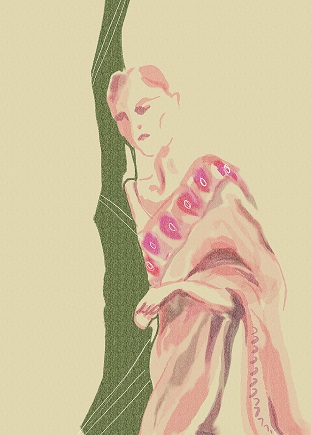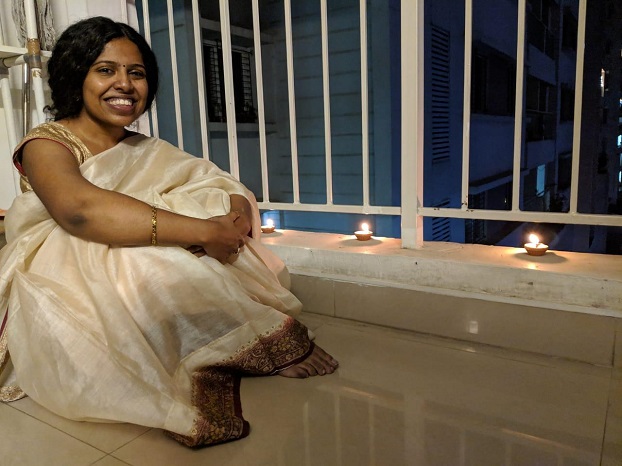
How the drape holds meaning and memory for the desi mind, body, and soul. A series of interview-vignettes, showcasing uber serious sari love, brought out via passion, history, politics, through interviews with people across the spectrum who love to drape it, and also, talk about it! Catch up with Chapter One‘s interview with impassioned crafts activist Laila Tyabji, Chapter Two‘s chat with filmmakers Shabani Hassanwalia and Paromita Vohra, and Chapter Three‘s Sari Sisters Jaya and Swaati.
* * *
“(I’ve been to) so many protests where my pallus have gone here and there — it’s all part of it.” — Sabika Naqvi
“I was busy making saris my political statement and in some time I gave up Fab India ‘cuz well, everybody had it, and now I was going back to older saris. Ma’s saris that were really old ones, but gorgeous ones, with hand-work, with paintings… I was done with the cotton only look.” — Jasmine Lovely George
One’s a poet, one’s a lawyer, and they’ve both got the feisty start-up attitude going for them. (Okay, Jasmine actually runs a start-up). Both understand the need for equal space in conversations around gender today, and also the need for dissent.
Here’s how we found the sari political, in our interviews with Sabika Naqvi and Jasmine Lovely George.
* * *
It all started in LSR [Lady Shri Ram College for Women], 2nd year college, when things start to get interesting and angsty, when Sabika started wearing a bindi. “Someone I knew told me, ‘Oh, you’re changing culturally.’ And I spat out, ‘Tumhara mazhab meri bindi ke chaaron taraf hi toh ghoomta hai (Oh of course. Your faith revolves around my bindi).’” The words took even Sabika by surprise — it had been such a gut reaction — and she found herself scribbling them in her notebook back home.
It felt like poetry. Indeed, it was.

It soon got Sabika claiming the sari in life and in verse — though in her case, these are interchangeable, or perhaps one and the same. “I discovered this Telugu poet Jayaprabha who wrote about how she wanted to burn the sari,” she says, drawing the linkages between poets and activists. “It’s beautiful to see how the sari works as a metaphor… Where we have reached today is the result of the struggles of so many women of the past. Savitribai Phule questioned the caste and place of women in society, which empowers me today. The fact that so many women have used the sari as metaphor, that each woman across time has used the sari to define resistance and struggle… urges me on today.”
Jasmine who took to the sari as political armor too — not counting the fancy dress competition she participated in and won at age five — would agree. “For the longest time, I associated myself as a body that is anything but graceful. I was in between spaces and sari was not really my game,” she shares.
Activism altered this for Jasmine, “It changed with my entry into political spaces. I was looking for a less beautiful reason to wear the sari. And protests became the perfect alternate space. People liked saris there — it looked radical and I was allowed to wear them and play with aesthetics.” This was why Jasmine started out with Fab India saris, she adds.
As her sari-wearing aesthetics evolved, Jasmine found herself going back to the woman who once turned up her nose at badly draped saris — her mother. “The previous generations are a lot more comfortable with their sari equations. They could work with it, run with it and yet keep their creases in place. They are not aware of it, they consider it as part of their bodies, unlike most of us who are still aware of the burden we carry, when one wears a sari.” Jasmine too has come a long way, “I love showing my navel off when wearing sari. Sari for me is femininity. The only place, where I will let my femininity play out.”
Sabika also has women-in-my-family sari stories, “When I moved to Delhi from Lucknow, my dadi, who only always wore saris, said to me, ‘Dilli mein sari bahut achchi milti hai, get me a firozi sari with a silver border.’ They turned out to be her last words to me, because in Delhi, I learnt that she had passed away.” For Sabika, sari equals memory, “I’m someone who doesn’t mind wearing old clothes. You know, clothes with ink-marks on them — those are all stories. I have this very old net sari, and the aanchal of it, it’s literally gal rahi hai. But I still wear it.” Sabika also bought that firozi sari, she tells us, and she paid tribute to her dadi with the ultimate act — she wore it to a poetry performance.

Jasmine has begun using the saree as a statement at international panels, “A style statement,” she qualifies, adding, “People identify you more with a certain argument and also, well, people think you look more beautiful.” She dwells more on the connect with the nation, in some ways, echoing what Laila Tyabji had expressed as a strong opinion in Chapter 1:
“Something about the sari is very, very personal and very, very tactile. It sticks to your body, it gives you a shape. I am even told it makes me look like a woman, and suddenly people can find curves in my body. Sari has dominated the Indian fantasy for sometime, and it does help us solve the rootlessness issue. After all nobody else owns a sari yet other than Indian beings.”
Sabika, who always brings back two things from the cities she visits — “pictures of the sky, and saris” — had had enough of the advice around wearing saris, “I was told that I’m not carrying saris too well — that I’m not graceful, that I haven’t tied it up properly, your petticoats aren’t tight enough, the pleats aren’t proper. “You should wear saris only when you know how to” — from someone I love dearly and still do. And I tried to wear them well. But now I say hum sari ko pehente hain, ya sari humein pehenti hai?”
You know who wears it like she owns it? Popular writer Anuja Chauhan. Up next, in Chapter 5 of Sari Stories.
* * *
Pooja Pande is a writer-editor who grew up in, considers home, and hence has a suitably complex love-hate relationship with the capital city of India, Delhi. Her first book is Red Lipstick, a literary-styled memoir on celebrity transgender rights activist Laxminarayan Tripathi. Find her on Twitter at @derrindo.












